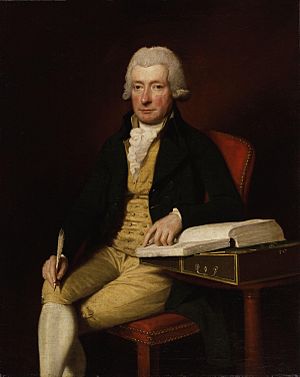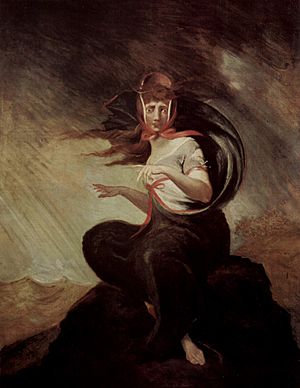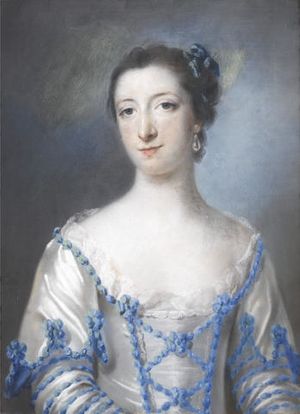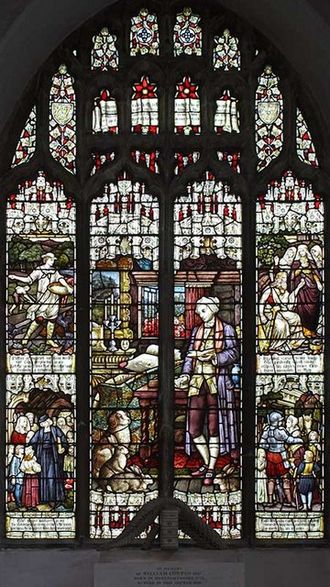William Cowper facts for kids
Quick facts for kids
William Cowper
|
|
|---|---|

A 1792 portrait by Lemuel Francis Abbott
|
|
| Born | 26 November 1731 Berkhamsted, Hertfordshire, England
|
| Died | 25 April 1800 (aged 68) East Dereham, Norfolk, England
|
| Education | Westminster School |
| Occupation | Poet |
William Cowper (/ˈkuːpər/ KOO-pər; 26 November 1731 – 25 April 1800) was a famous English poet. He also wrote many Christian songs, called hymns. He was one of the most popular poets of his time.
Cowper changed how people wrote about nature in the 1700s. He wrote about everyday life and the beautiful English countryside. Many people see him as a pioneer of Romantic poetry. Famous poets like Samuel Taylor Coleridge and William Wordsworth admired his work.
William Cowper faced challenges with his mental health. After a difficult period, he found comfort in his Christian faith. He continued to write religious hymns and poems.
His strong faith and friendship with John Newton (who wrote "Amazing Grace") led to many of his well-known poems. These include the "Olney Hymns" collection. One of his poems, "Light Shining out of Darkness", gave us the famous line: "God moves in a mysterious way/ His wonders to perform."
Cowper also wrote poems against slavery. His friend John Newton was a strong anti-slavery campaigner. Newton asked Cowper to write in support of the movement to end slavery. Cowper wrote "The Negro's Complaint" (1788), which became very popular. Martin Luther King Jr. often quoted it during the civil rights movement in the 20th century.
Contents
Early Life and Education
William Cowper was born in Berkhamsted, England. His father, John Cowper, was a church leader there. William's mother, Ann, died when he was only six years old. This deeply affected him. He later wrote a poem about her, "On the Receipt of My Mother's Picture".
William was very close to his mother's family. Her brother, Robert, and his wife, Harriot, encouraged his love for reading. They gave him some of his first books, like Pilgrim’s Progress.
Cowper started at Westminster School in 1742. He had moved between different schools before this. He began studying Latin at a young age and loved it his whole life. Older students sometimes bullied him when he was younger.
At Westminster, he read the Iliad and the Odyssey. These ancient Greek poems made him love Homer's stories. He became very good at understanding and translating Latin. He also wrote many of his own poems in Latin.
Challenges and Faith
After school, Cowper trained to become a lawyer. During this time, he fell in love with his cousin, Theodora. He wanted to marry her, but her father said no. This made Cowper very sad. He then experienced a difficult period with his mental health.
In 1763, he was offered a job in the House of Lords. But the stress of the exam for the job was too much. He had another period of mental health struggles.
After recovering, he moved to Huntingdon. He lived with a retired clergyman, Morley Unwin, and his wife, Mary Unwin. Cowper became very good friends with the Unwin family. He moved with them to Olney.
In Olney, he met John Newton, a church leader. Newton had once been a captain of slave ships. He had then dedicated his life to spreading the Christian message. Morley Unwin sadly died after falling from his horse. Cowper continued to live with Mary Unwin and became very close to her.
Newton asked Cowper to help him write a hymnbook. This book, called Olney Hymns, was published in 1779. It includes famous hymns like "There is a fountain fill'd with blood" and "God Moves in a Mysterious Way". These are still some of Cowper's most well-known verses.
In 1773, Cowper had another period of mental health struggles. He worried he was going to be punished forever. Mary Unwin cared for him with great dedication. After a year, he began to feel better.
In 1779, Newton moved to London. Cowper started writing poetry again. Mary Unwin wanted to keep his mind busy. She suggested he write about "The Progress of Error." He wrote several poems on this topic. These were published in 1782 as Poems by William Cowper.
Later Life and Works

In 1781, Cowper met Lady Austen, a smart and charming widow. She inspired him to write new poems. In the same book, he also published "The Diverting History of John Gilpin". This was a very funny poem. Some people say writing "John Gilpin" helped Cowper avoid further mental health challenges.

Cowper and Mary Unwin moved to Weston Underwood, Buckinghamshire, in 1786. He became close with his cousin, Lady Harriett Hesketh. During this time, he began translating Homer's Iliad and Odyssey into English. His translations were published in 1791. They were the most important English versions of these epic poems since Alexander Pope's earlier ones.
In 1789, Cowper became friends with another cousin, Dr John Johnson. In 1795, Cowper and Mary moved to Norfolk to be near him. They lived in several places before settling in East Dereham with the Johnsons. This was after Mary Unwin became unwell.
Mary Unwin died in 1796. This made Cowper very sad, and he never fully recovered his spirits. He continued to work on his Homer translations. He also wrote a powerful poem called "The Castaway". He translated some Greek poems and some of John Gay's Fables into Latin.
Death and Memorials

Cowper became very ill with a condition called edema in the spring of 1800. He died on April 25th. He is buried in St Nicholas's Church in East Dereham. A stained-glass window there remembers his life.
In St Peter's Church in Berkhamsted, there are two windows dedicated to Cowper. One shows him at his writing desk with his pet hares. The other has lines from his poems. There is also a memorial for his mother, Ann Cowper, in the same church. Cowper is also remembered in a stained-glass window in St George's Chapel, Westminster Abbey.
In 1823, Cowper's letters were published after his death.
Near Weston Underwood, where Cowper lived, there is a small building called Cowper's Alcove. It was built in 1753. Cowper often visited this spot for inspiration for his poetry. The alcove is mentioned in his poem "The Task." A plaque with a verse from "The Task" is now there.
Famous Poems and Hymns
Poems
- The Snail, 1730
- The Winter Nosegay, 1777
- Olney Hymns, 1778–1779 (with John Newton)
- John Gilpin, 1782
- Epitaph on a Hare, 1782
- Poems by William Cowper, 1782 (his first collection)
- The Rose, 1783
- The Task, 1785
- The Morning Dream, 1788
- Iliad and Odyssey, 1791 (translations of Homer)
- The Retired Cat, 1791
- To Mary, 1793
- On the Ice Islands Seen Floating in the German Ocean, 1803
- The Castaway, 1803
- The Poplar-Field, 1785
- Lines Written During a Period of Insanity, 1816
Hymns
Cowper wrote many hymns that are still sung today. Here are some of them:
- "Jesus! where'er thy people meet"
- "The Spirit breathes upon the word"
- "There is a fountain, filled with blood"
- "Hark! my soul! it is the Lord"
- "To Jesus, the Crown of my hope"
- "Far from the world, O Lord! I flee"
- "My Lord! how full of sweet content"
- "What various hindrances we meet"
- "Oh! for a closer walk with GOD"
- "When darkness long has veiled my mind"
- "'Tis my happiness below"
- "O Lord! in sorrow I resign"
- "O Lord! my best desire fulfill"
- "There is a safe and secret place"
- "God of my life! to thee I call"
Well-Known Quotes
|
GOD moves in a mysterious way, There is a fountain fill'd with blood Oh! for a closer walk with GOD, God made the country, and man made the town. There is a pleasure in poetic pains |
Variety's the very spice of life, I am monarch of all I survey, No voice divine the storm allay'd, 'Tis pleasant, through the loopholes of retreat, |
See Also
 In Spanish: William Cowper para niños
In Spanish: William Cowper para niños


